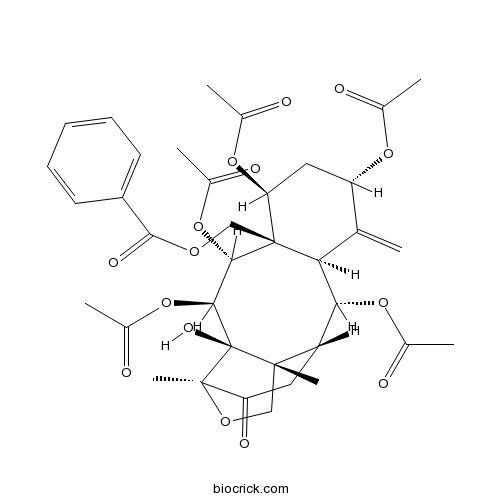Taxumairol RCAS# 244167-04-2 |

Quality Control & MSDS
3D structure
Package In Stock
Number of papers citing our products

| Cas No. | 244167-04-2 | SDF | Download SDF |
| PubChem ID | 21593833 | Appearance | Powder |
| Formula | C37H44O15 | M.Wt | 728.74 |
| Type of Compound | Diterpenoids | Storage | Desiccate at -20°C |
| Solubility | Soluble in Chloroform,Dichloromethane,Ethyl Acetate,DMSO,Acetone,etc. | ||
| Chemical Name | [(1R,2R,3S,4R,5R,6S,8S,10R,11R,12R,15S)-3,4,6,8,11-pentaacetyloxy-2-hydroxy-1,15-dimethyl-9-methylidene-14-oxo-16-oxatetracyclo[10.5.0.02,15.05,10]heptadecan-5-yl]methyl benzoate | ||
| SMILES | CC(=O)OC1CC(C2(C(C1=C)C(C3CC(=O)C4(C(C3(CO4)C)(C(C2OC(=O)C)OC(=O)C)O)C)OC(=O)C)COC(=O)C5=CC=CC=C5)OC(=O)C | ||
| Standard InChIKey | XUMIEQQAVQWNBJ-CCCKHRJYSA-N | ||
| Standard InChI | InChI=1S/C37H44O15/c1-18-26(48-19(2)38)15-28(49-20(3)39)36(17-46-33(44)24-12-10-9-11-13-24)29(18)30(50-21(4)40)25-14-27(43)35(8)37(45,34(25,7)16-47-35)32(52-23(6)42)31(36)51-22(5)41/h9-13,25-26,28-32,45H,1,14-17H2,2-8H3/t25-,26-,28-,29-,30+,31-,32-,34-,35+,36+,37-/m0/s1 | ||
| General tips | For obtaining a higher solubility , please warm the tube at 37 ℃ and shake it in the ultrasonic bath for a while.Stock solution can be stored below -20℃ for several months. We recommend that you prepare and use the solution on the same day. However, if the test schedule requires, the stock solutions can be prepared in advance, and the stock solution must be sealed and stored below -20℃. In general, the stock solution can be kept for several months. Before use, we recommend that you leave the vial at room temperature for at least an hour before opening it. |
||
| About Packaging | 1. The packaging of the product may be reversed during transportation, cause the high purity compounds to adhere to the neck or cap of the vial.Take the vail out of its packaging and shake gently until the compounds fall to the bottom of the vial. 2. For liquid products, please centrifuge at 500xg to gather the liquid to the bottom of the vial. 3. Try to avoid loss or contamination during the experiment. |
||
| Shipping Condition | Packaging according to customer requirements(5mg, 10mg, 20mg and more). Ship via FedEx, DHL, UPS, EMS or other couriers with RT, or blue ice upon request. | ||
| Description | Taxumairol R is a natural product from Taxus mairei. |
| Structure Identification | Journal of the Chinese Chemical Society, 2013, 47(5):1125-30.Taxane Diterpenoids from the Root Bark of Taiwanese Yew Taxus Mairei[Reference: WebLink]
|

Taxumairol R Dilution Calculator

Taxumairol R Molarity Calculator
| 1 mg | 5 mg | 10 mg | 20 mg | 25 mg | |
| 1 mM | 1.3722 mL | 6.8612 mL | 13.7223 mL | 27.4446 mL | 34.3058 mL |
| 5 mM | 0.2744 mL | 1.3722 mL | 2.7445 mL | 5.4889 mL | 6.8612 mL |
| 10 mM | 0.1372 mL | 0.6861 mL | 1.3722 mL | 2.7445 mL | 3.4306 mL |
| 50 mM | 0.0274 mL | 0.1372 mL | 0.2744 mL | 0.5489 mL | 0.6861 mL |
| 100 mM | 0.0137 mL | 0.0686 mL | 0.1372 mL | 0.2744 mL | 0.3431 mL |
| * Note: If you are in the process of experiment, it's necessary to make the dilution ratios of the samples. The dilution data above is only for reference. Normally, it's can get a better solubility within lower of Concentrations. | |||||

Calcutta University

University of Minnesota

University of Maryland School of Medicine

University of Illinois at Chicago

The Ohio State University

University of Zurich

Harvard University

Colorado State University

Auburn University

Yale University

Worcester Polytechnic Institute

Washington State University

Stanford University

University of Leipzig

Universidade da Beira Interior

The Institute of Cancer Research

Heidelberg University

University of Amsterdam

University of Auckland

TsingHua University

The University of Michigan

Miami University

DRURY University

Jilin University

Fudan University

Wuhan University

Sun Yat-sen University

Universite de Paris

Deemed University

Auckland University

The University of Tokyo

Korea University
- L-798,106
Catalog No.:BCC7654
CAS No.:244101-02-8
- Beta-Rotunol
Catalog No.:BCN6628
CAS No.:24405-57-0
- (+)-Epipinoresinol
Catalog No.:BCN3255
CAS No.:24404-50-0
- beta-D-glucose
Catalog No.:BCN8171
CAS No.:492-61-5
- TAK-242
Catalog No.:BCC1977
CAS No.:243984-11-4
- TAK-242 S enantiomer
Catalog No.:BCC1978
CAS No.:243984-10-3
- TCS 401
Catalog No.:BCC2469
CAS No.:243967-42-2
- Cnicin
Catalog No.:BCN8546
CAS No.:24394-09-0
- Ethyl 4-methoxycinnamate
Catalog No.:BCN5028
CAS No.:24393-56-4
- Kynurenic acid sodium salt
Catalog No.:BCC7754
CAS No.:2439-02-3
- 5-Iodotubercidin
Catalog No.:BCC1312
CAS No.:24386-93-4
- Glycoside L-F2
Catalog No.:BCN2158
CAS No.:243857-99-0
- L-748,337
Catalog No.:BCC7475
CAS No.:244192-94-7
- Pulchinenoside E2
Catalog No.:BCN8186
CAS No.:244202-36-6
- Celaphanol A
Catalog No.:BCN5101
CAS No.:244204-40-8
- JTC-801
Catalog No.:BCC3800
CAS No.:244218-51-7
- LFM-A13
Catalog No.:BCC6472
CAS No.:244240-24-2
- 3,5,7,15-Tetraacetoxy-9-nicotinoyloxy-6(17),11-jatrophadien-14-one
Catalog No.:BCN6592
CAS No.:244277-75-6
- Nonivamide
Catalog No.:BCN2325
CAS No.:2444-46-4
- Daphnetin dimethyl ether
Catalog No.:BCN2735
CAS No.:2445-80-9
- 4-Chlorodehydromethyltestosterone
Catalog No.:BCC8704
CAS No.:2446-23-3
- Sanguinarine
Catalog No.:BCN5102
CAS No.:2447-54-3
- Sulfadoxine
Catalog No.:BCC4726
CAS No.:2447-57-6
- Pseudoakuammigine
Catalog No.:BCN4812
CAS No.:2447-70-3
Taxane Diterpenoids from the Root Bark of Taiwanese Yew Taxus Mairei
Journal of the Chinese Chemical Society, 2013, 47(5):1125-30.
Nineteen compounds including Taxumairol R (1), taxinine M (2), taxacin (3), paclitaxel (4), 10-deacetyltaxol A (5), 10-deacetyl-7-epi-taxol (6), 7-epi-taxol (7), taxol C, 10-deacetyltaxol C, 7β-xylosyl-10-deacetyltaxol (8), taxamairin A (9), taxinine A, 14β-hydroxytaxusin (10), 5-hydroxy-7β,9,10β, 13-tetraacetoxy-4(20), 11-taxadiene, 1-dehydroxybaccatin-VI, 1β-dehydroxybaccatin-IV, baccatin IV, baccatin VI and ponasterone A have been isolated and identified from the root bark of Taxus mairei. Among them, compound 1 was a new taxoid and compounds 11 and 7β-xylosyl-10-deacetyltaxol pentaacetate were new derivatives prepared from 14β-hydroxytaxusin (10) and 8, respectively. Their structures and assignment were established on the basis of 2D-NMR analysis and chemical methods.


